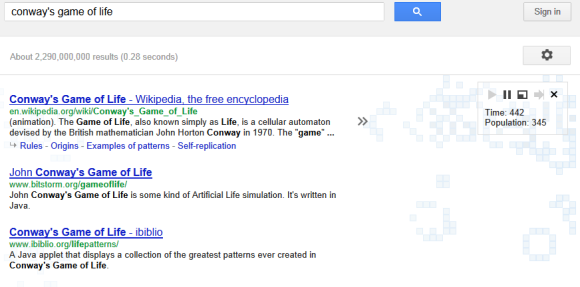Google shows a clever Easter Egg when you’re searching for [conway’s game of life]. It’s a low-key simulation of John Conway’s model devised in 1970. “The universe of the Game of Life is an infinite two-dimensional orthogonal grid of square cells, each of which is in one of two possible states, alive or dead. Every cell interacts with its eight neighbours, which are the cells that are horizontally, vertically, or diagonally adjacent,” explains Wikipedia.

It’s not an actual game because it doesn’t require input. There’s an initial configuration and all the other configurations are obtained by applying 4 rules:
“Any live cell with fewer than two live neighbours dies, as if caused by under-population. Any live cell with two or three live neighbours lives on to the next generation. Any live cell with more than three live neighbours dies, as if by overcrowding. Any dead cell with exactly three live neighbours becomes a live cell, as if by reproduction.”
Conway’s Game of Life is a cellular automaton and it can emulate a universal Turing machine.
You can pause Google’s simulation and even hide the search results by clicking the maximize button. If you don’t like the Easter Egg, click the close button and it disappears. There’s also a simplified version of the Easter Egg for smartphones and tablets, but the controls are missing.
{ Thanks, Dan. }